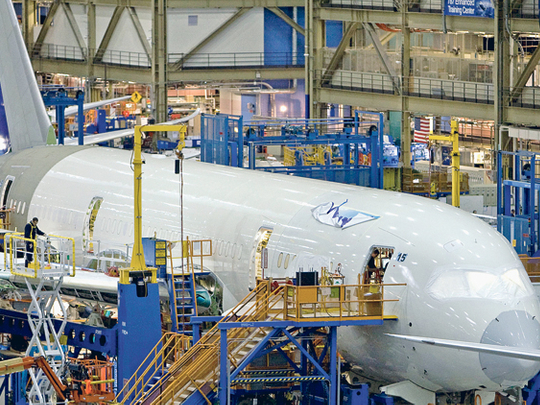Boeing faces financial drag from dozens of undelivered 787 jets

Washington: Boeing Co. is running out of space to stash newly-built 787 Dreamliners, with jetliners seemingly tucked onto every available patch of pavement on airfields near its factories in Washington and South Carolina.
Dozens of the planes are sitting on the company’s premises, according to people familiar with the situation. Uresh Sheth, a much-followed blogger who meticulously tracks the Dreamliners rolling through Boeing’s factories, puts the total somewhere above 50. That’s more than double the number of jets typically awaiting customers along Boeing’s flight lines.
Brand-new widebodies are lined up on a closed off runway at the airport that abuts Boeing’s hulking plant north of Seattle. In North Charleston, 787s are tucked around the delivery center and a paint hangar. The U.S. planemaker has even started sending aircraft to be stored in a desert lot in Victorville, California, according to Sheth.
After last year’s global grounding of 737 Max jets, the company had so many of them on hand it commandeered an employee parking lot to store surplus aircraft. Now, as it finally starts to emerge from that crisis, another critical source of cash - the marquee 787 - is under pressure.
Boeing had relied on the wide-body jet, produced in record numbers, to help bankroll the $20 billion in costs it has rung up since the Max was banned from commercial flight in March 2019 following two fatal crashes. But as Covid-19 sapped consumer interest in long-range travel this year, the tally of undelivered Dreamliners has stacked up and created a new financial drag as regulators move closer to clearing the 737’s return.
“The next couple of years are just going to be very hard for this airplane,” George Ferguson, an analyst with Bloomberg Intelligence, said of the 787 Dreamliner.
Capacity Hangover
Demand for the twin-aisle 787, Boeing’s 777 and Airbus’s A350 and A330neo has been especially hard hit as cash-strapped airlines slow or cancel aircraft purchases. Some would-be buyers don’t want to send pilots to claim aircraft in the U.S., where the pandemic is raging. When they are able to start growing fleets, airlines are expected to initially focus on smaller planes for domestic flights before adding larger aircraft for continent-hopping trips.
Boeing also faces a “capacity hangover” after pushing Dreamliner production to a 14-jet monthly pace last year - a record for wide-body aircraft - in a market that was already glutted with aircraft, said Richard Aboulafia, an analyst with Teal Group.
“It was one of the few levers they could pull to bring in more cash during what seemed like a crisis, and now looks like a nothingburger,” Aboulafia said of Boeing’s response to the Max grounding. That scandal has been eclipsed by the unprecedented aviation collapse brought on by Covid-19. “No twin-aisle had ever been built at 14-a-month for a very good reason.”
Boeing declined to comment specifically on the number of 787s in its inventory or production plans, citing a quiet period.
“We continue to closely monitor the commercial marketplace by staying very engaged with our customers around the globe to fully understand short term and long term requirements,” Greg Smith, the company’s chief financial officer and executive vice president of enterprise operations, said in a statement.
Hard to Clear
Customers took just three of Boeing’s 787 during May and June, and 36 of the aircraft in the first six months of the year. That’s down from 78 deliveries a year earlier.
Boeing has already lowered 787 production to 10 jets a month, with deeper cuts to come over the next two years. Still, the manufacturer could be left holding one-third of the more than 100 Dreamliners that J.P. Morgan analyst Seth Seifman projects the company will build this year.
“It may be difficult to clear this inventory next year,” given that Boeing would have to ramp up deliveries at a time when “when long-range travel may still be under pressure,” Seifman said in a July 15 report.
Boeing’s ballooning 787 inventory and deferred production costs should come into sharper focus over the next two weeks as key customers like American Airlines Group Inc. and United Airlines Holdings Inc. report earnings, followed by the Chicago-based manufacturer on July 29.
Comments